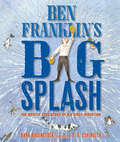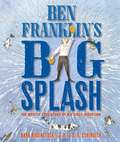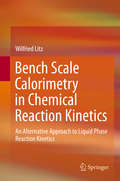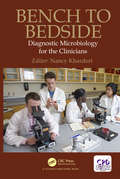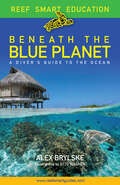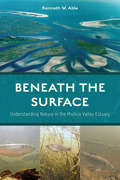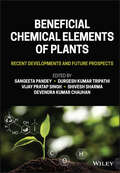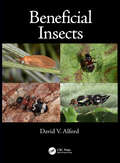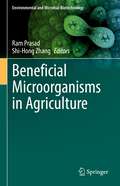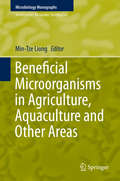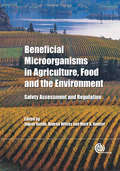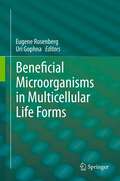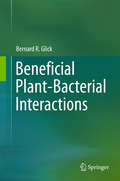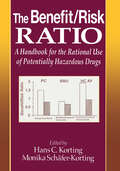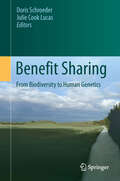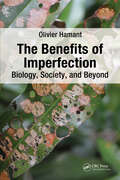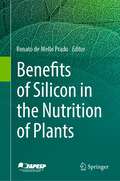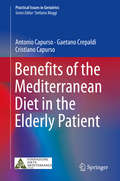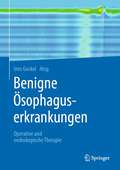- Table View
- List View
The Ben Franklin Book of Easy and Incredible Experiments: A Franklin Institute Science Museum Book
by Franklin Institute Science MuseumLearn about science the same way Ben Franklin did--by performing incredible experiments Ben Franklin, the famous patriot and signer of the Declaration of Independence, was also America's first great scientist.
Ben Franklin's Big Splash: The Mostly True Story of His First Invention
by Barb RosenstockA National Science Teachers Association, Best STEM BookHere is the story of Ben Franklin's first invention, his journey through the scientific method, and the surprising successes that result when you're willing to make mistakes.Every inventor has to start somewhere, and one of the greatest innovators in our history was no exception. Ben Franklin developed his first invention while doing what he loved best: swimming! Barb Rosenstock's rhythmic, whimsical style is the perfect complement to S. D. Schindler's pen and ink and watercolor illustrations. Together they recreate history in an engaging and unique way. Both author and illustrator worked closely with Franklin experts, and the book includes Franklin quotes, an extensive author's note, timeline, and bibliography.
Ben Franklin's Big Splash: The Mostly True Story Of His First Invention
by Barb Rosenstock S. D. SchindlerEvery inventor has to start somewhere, and one of the greatest innovators in our history was no exception. Ben Franklin developed his first invention while doing what he loved best: swimming! Ben's Big Splash is the story of Franklin's first invention, his journey through the scientific method, and the surprising successes that result when you're willing to make mistakes. Barb Rosenstock's rhythmic, whimsical style is the perfect complement to S. D. Schindler's pen and ink and watercolor illustrations. Together they recreate history in an engaging and unique way. Both author and illustrator worked closely with Franklin experts, and the book includes Franklin quotes, an extensive author's note, timeline, and bibliography.
The Bench Grafter's Handbook: Principles & Practice
by Brian E. HumphreyContaining 500 full color photographs and illustrations, The Bench Grafter’s Handbook: Principles and Practice presents exhaustive information on all aspects of bench grafting. It details requirements of more than 200 temperate woody plant genera, covering over 2,000 species and cultivars including important ornamental, temperate fruit, and nut crops. The book explains the principles and practices of bench grafting, new procedures to enhance grafting success, and recommendations for further scientific investigation. Practical issues to aid professionals and the beginner, include detailed accounts, supported by pictures and diagrams, of the main grafting methods, knifesmanship techniques, and methods of training. Provision and design, now and for the future, of suitable structures, grafting facilities, and equipment, to provide ideal controlled environments for grafts, are described. The book describes major grafting systems, sub-cold, cold, warm, supported warm, hot-pipe, and other grafting strategies. It provides details of health and safety issues; work stations, seat design, lighting levels; recorded output figures for various types of graft; grafting knives and tools; and methods of sharpening by hand and machine. Features: Comprehensive description, pictures, and diagrams of how to learn and utilize important grafting methods. Detailed information and scientific principles behind the selection, specification, and choice of the main graft components – the rootstock and scion. Scientific principles and practicalities of providing optimal plant material, equipment, facilities and environmental conditions for graft union development including addressing the problems of graft incompatibility. Discussion of the actual and potential role of bench grafting in woody plant conservation with suggestions for new initiatives. This book is intended for use by nurserymen; those involved in the upkeep of extensive plant collections; conservationists; plant scientists; lecturers in horticulture; horticultural students; and amateurs with an interest in grafting.
Bench Scale Calorimetry in Chemical Reaction Kinetics: An Alternative Approach to Liquid Phase Reaction Kinetics
by Wilfried LitzThis book describes new and efficient calorimetric measurement methods, which can be used to accurately follow the chemical kinetics of liquid phase reaction systems. It describes apparatus and techniques for the precise measuring of the rate of heat liberation in discontinuous and continuous isothermal as well as non-isothermal reactions. The presented methodology can be used to follow the development of chemical reactions online, even in industrial scales. Written by an experienced scientist and practitioner, who can look back on long-standing expert knowledge in chemical engineering, the book contains many practical hints and instructions. The reader will find a sound compact introduction to fundamentals, and comprehensive technical background information and instructions for performing own kinetic experiments. This book is the fusion of scientific background information and long hands-on experience in the practice.
Bench to Bedside: Diagnostic Microbiology for the Clinicians
by Nancy KhardoriThis reference text is a must have for any current or future clinicians or students of microbiology. It is concisely organized to provide vital information on many of the microbes one will regularly encounter and the most efficacious ways of addressing associated infections. Discussion of antimicrobial resistance mechanisms and measures to combat them are also one of the key features of this text. Whether you desire to utilize this book at the bedside for prompt treatment decisions or as a reference manual to be used at your leisure, you will find it to be a valuable addition to your library.
Beneath the Blue Planet: A Diver's Guide to the Ocean and Its Conservation (Reef Smart Education)
by Alex BrylskeTake a Deep Dive into the Secrets of Our Blue Planet"The author is one of the most experienced in the world. A fascinating and engaging toom. Well worth the read. A valued forever reference." —Amazon review#1 New Release in Scuba Travel GuidesVenture into the thrilling realm of underwater exploration with Beneath the Blue Planet by the founders of the popular Reef Smart Guides series for snorkelers and scuba divers. A perfect travel gift for nature lovers and a rich source of shark facts, this book unearths the secrets of the ocean, from coral reefs to the world of deep diving.Dive into the ocean's untold stories. Discover the captivating universe that exists beneath the waves. From the diverse inhabitants of the coral reefs to the deepest, most mysterious corners of the ocean, Beneath the Blue Planet unveils everything you've ever wanted to know about our underwater world.Experience the thrill of ocean exploration. This immersive guide provides fascinating shark facts, explores the incredibly beautiful world of coral reefs, and encourages sustainable tourism for divers. Designed for anyone who loves the ocean, this book is a treasure trove of knowledge, making it an excellent travel gift for adventure seekers.Immerse yourself in Beneath the Blue Planet and:Unearth the hidden world of ocean reefs, and understand their essential role in marine ecosystemsGain invaluable insights into snorkeling and deep diving, enhancing your ocean exploration adventuresExplore intriguing shark facts, providing a closer look at these fascinating marine creaturesDiscover practical ways to contribute to ocean conservation, turning your love for the seas into meaningful actionIf you've read Oceanology, National Geographic A Diver's Guide to the World, or100 Dives of a Lifetime, and are a fan of the Reef Smart Guides dive and snorkel travel series, you’ll love Beneath the Blue Planet.
Beneath the Surface: Understanding Nature in the Mullica Valley Estuary
by Kenneth W. AbleThe Mullica Valley estuary and its watershed, formed over the last 10,000 years, are among the cleanest estuaries along the east coast of the United States. This 365,000-acre ecosystem benefits from a combination of protected watershed, low human population density, and general lack of extensive development. In Beneath the Surface, marine scientist Ken Able helps the reader penetrate the surface and gain insights into the kinds of habitats, animals, and plants that live there. Readers will gain a better understanding of the importance of these shallow waters; how the amount of salt in the water determines where animals and plants are found in estuaries; the day-night, seasonal, and annual variation in their occurrence; and how change is occurring as the result of climate variation. Throughout the book are insightful sidebars telling intimate stories of where various animals came from and where they are going as they travel through the estuary on their way to and from other portions of the east coast. Beneath the Surface emphasizes the kinds and importance of the animals and plants that live beneath the surface of this unique ecosystem.
Beneficial Chemical Elements of Plants: Recent Developments and Future Prospects
by Sangeeta Pandey Durgesh Kumar Tripathi Vijay Pratap Singh Shivesh Sharma Devendra Kumar ChauhanBENEFICIAL CHEMICAL ELEMENTS OF PLANTS Understand beneficial elements and their role in the future of botany and agriculture Beneficial elements are those which, while not essential to plant life, can provide stimulation and enhance plant growth. Properly harnessed, these elements can bolster plant growth in the face of environmental conditions—including drought, nutrient deficiency, and excessive soil salinity—and biotic stresses like pathogens and animal activity. As climate change and population growth pose increasingly serious challenges to agriculture and essential plant production, it has never been more important to unleash the potential of beneficial elements. Beneficial Chemical Elements of Plants is an essential resource for researchers and industry specialists looking to enhance their understanding of these elements and the range and variety of their enhancements to plant growth. Written by leading scholars in the field of plant stress tolerance and nutrient enrichment, it discusses not only the rich possibilities of beneficial elements but their mechanisms of action at both biochemical and molecular levels. It details the precise potential roles played by each major beneficial element and surveys a range of elemental responses to specific environmental conditions and plant stresses. Beneficial Chemical Elements of Plants readers will also find: Chapters covering beneficial elements including aluminum, cobalt, sodium, selenium, and silicon Discussion of application methods and typical plant responses Treatment of beneficial elements in a wider environmental context Beneficial element applications to the field of sustainable agriculture Beneficial Chemical Elements of Plants is a fundamental starting point for researchers and students in the fields of plant physiology, crop science, agriculture, and botany, as well as for professionals in the biotechnology and agricultural industries.
Beneficial Insects
by David AlfordInsects are key components of life on our planet, and their presence is essential for maintaining balanced terrestrial ecosystems. Without insects humans would struggle to survive, and on a world scale food production would be severely compromised. Many plants and animals depend directly or indirectly on insects for their very survival, and this is particularly so in the case of insectivorous birds and other such creatures. The beneficial role of insects is often overlooked or misunderstood, and in farming circles their very presence on crops is often seen to be unwelcome. In reality, however, many insects are genuinely beneficial, as in the case of parasitic and predacious species. The use of chemical pesticides to control crop pests is becoming more tightly regulated and environmentally undesirable, and low-input farming, in which natural enemies of pests are encouraged to survive or increase, is becoming far more prevalent. Accordingly, Integrated Pest Management (IPM) and Integrated Pest Management (ICM) strategies are increasingly being developed, advocated and adopted. <p><p>Features: <li>Highlights information on many groups of insects and mites that act as natural enemies or biological control agents of phytophagous insects and mites, including plant pests. <li>Profusely illustrated with high-quality colour photographs. <li>Focuses mainly on insects and mites as natural enemies of plant pests, including parasitic and predacious species that have been accidentally or deliberately introduced in classical biological control programmes. <li>Reviews the role of phytophagous European insects and mites in controlling or managing European plants that have become invasive weeds in other parts of the world, notably North America, Australia and New Zealand.
Beneficial Microorganisms in Agriculture (Environmental and Microbial Biotechnology)
by Ram Prasad Shi-Hong ZhangThis book discusses genetic engineering of both plants and microbes for making agricultural practices more productive and sustainable. It chapters explore the understanding of the interaction between plants and microbes, and genomic information to modify the metabolism of plants or microbes to further enhance the beneficial interaction. The book covers the development of commercial inoculants including selection of appropriate plant growth-promoting rhizobacteria/ phosphate solubilize bacteria based on target host plant, soil type, indigenous microbial communities, environmental conditions, inoculant density, suitability of carriers and compatibility with integrated crop management. This is a relevant content for scientists and researchers working on soil biology, sustainable agricultural and plant physiology. Also, this book is a useful read for graduate and post graduate students of agriculture, botany and microbiology.
Beneficial Microorganisms in Agriculture, Aquaculture and Other Areas (Microbiology Monographs #29)
by Min-Tze LiongThis book focuses on the use of microorganisms in relation to agriculture, aquaculture and related fields, ranging from biofertilizers to poultry production. The latest innovations are also included to provide insights into the unlimited potentials of microorganisms in these areas. Individual chapters explore topics such as probiotics in poultry, biopurification of wastewater, converting agrowastes into value-added applications and products, rice cultivation, surfactants and bacteriocin as biopreservatives, bioplastics, crop productivity, biofloc, and the production of natural antibiotics. This volume will be of particular interest to scientists, policymakers and industrial practitioners working in the fields of agriculture, aquaculture and public health.
Beneficial Microorganisms in Agriculture, Food and the Environment
by Stephen Jaronski Carl-Gustaf Thornstrom Andrea Wilcks Keith Warner Ingvar Sundh Stephen Wessels Avrelija Cencic Milton Typas Barbara Pernfuss Roland Mollby Niels Hendriksen John Howieson Rudiger Hauschild Peter Van Baarlen Anne Madsen Michael Frodyma C Kurz Claude Alabouvette Mark Goettel Trudy Wassenaar Atte Von Wright Jeroen Meussen Harry Evans Gregorio Loprieno Andrew Chesson Michael WisniewskiMicroorganisms are widely used in various beneficial applications, including food, pest control, bioremediation, biodegradation, biofuel processes, and plant symbiosis and growth stimulation. his book provides an overview of the available methodology for safety assessments of microorganisms, including determination of their infectivity and whether they produce toxic or sensitising substances. Also covered are the regulatory systems in risk assessment and management of microbial products, quarantine legislations, international treaties, the importance of public risk perception and risk reduction behaviour.
Beneficial Microorganisms in Medical and Health Applications (Microbiology Monographs #28)
by Min-Tze LiongThis volume is devoted to the application of microorganisms in medical treatment and health protection. Topics discussed include the role of probiotics in immune modulation, in prevention of influenza, and in atopic dermatitis. Further chapters cover aspects such as the relation of the gut microbiome and stress, the immune system, the regulation of inflammation, the benefits of Bifidobacterium for infants, and bacteriocin in medical applications, as well as the use of in vitro models of the gastrointestinal tract, omics approaches for targeting microbial health potential and the production of hepatitis B vaccines. This volume will be of particular interest to scientists working in the fields of clinical medicine, applied microbiology, pharmacy and public health.
Beneficial Microorganisms in Multicellular Life Forms
by Eugene Rosenberg Uri GophnaAll animals and plants form associations with hundreds or thousands of different beneficial microorganisms. These symbiotic microbes play an important role in the development, adaptation, health and evolution of their hosts. This book brings together a group of diverse biologists to discuss microbial interactions with multicellular life forms including insects, corals, plants, and mammals, including humans. The various mechanisms by which microorganisms benefit their hosts are discussed, including providing essential nutrients, preventing disease, inducing the immune system, and combating stress. Since the microbiota can be transferred from parent to offspring, it plays an important role in the origin and evolution of animal and plant species. This book should be of interest to the widest range of biological scientists, merging the studies of host and microbial physiology, symbiosis, and the ecology and evolution of symbiotic partners.
Beneficial Plant-Bacterial Interactions
by Bernard R. GlickThis monograph provides an overview of beneficial plant-bacterial interactions in a straightforward and easy-to-understand format, and includes a wealth of unique illustrations elaborating every major point. Study questions that emphasize the key points are provided at the end of each chapter. One way to feed all of the people in the world's growing population is through the increased use of plant-growth-promoting bacteria in agriculture. These bacteria not only directly promote growth but also protect plants against a wide range of biotic and abiotic stresses. Moreover, they can be used to support procedures for biologically cleaning up the environment. Plant-growth-promoting bacteria are already being used successfully on a small scale in several countries, and as this technology matures, the world may witness a major paradigm shift in agricultural practice.
Beneficial Plant-Bacterial Interactions
by Bernard R. GlickThis book provides a straightforward and easy-to-understand overview of beneficial plant-bacterial interactions. It features a wealth of unique illustrations to clarify the text, and each chapter includes study questions that highlight the important points, as well as references to key experiments. Since the publication of the first edition of Beneficial Plant-Bacterial Interactions, in 2015, there has been an abundance of new discoveries in this area, and in recent years, scientists around the globe have begun to develop a relatively detailed understanding of many of the mechanisms used by bacteria that facilitate plant growth and development. This knowledge is gradually becoming an integral component of modern agricultural practice, with more and more plant growth-promoting bacterial strains being commercialized and used successfully in countries throughout the world. In addition, as the world’s population continues to grow, the pressure for increased food production will intensify, while at the same time, environmental concerns, mean that environmentally friendly methods of food production will need to replace many traditional agricultural practices such as the use of potentially dangerous chemicals. The book, intended for students, explores the fundamentals of this new paradigm in agriculture, horticulture, and environmental cleanup.
The Benefit/Risk Ratio: A Handbook for the Rational Use of Potentially Hazardous Drugs
by Hans C. Korting M. Schafer-KortingThe use of drugs as remedies for various types of diseases has a long tradition; however, it has only been recently recognized that the value of any given compound must be evaluated in light of its benefit to risk ratio. When prescribing drugs, physicians must look at the big picture of the drug's benefits in relation to its side effects and possib
Benefit Sharing: From Biodiversity to Human Genetics
by Doris Schroeder Julie Cook LucasBiomedical research is increasingly carried out in low- and middle-income countries. International consensus has largely been achieved around the importance of valid consent and protecting research participants from harm. But what are the responsibilities of researchers and funders to share the benefits of their research with research participants and their communities? After setting out the legal, ethical and conceptual frameworks for benefit sharing, this collection analyses seven historical cases to identify the ethical and policy challenges that arise in relation to benefit sharing. A series of recommendations address possible ways forward to achieve justice for research participants in low- and middle-income countries.
The Benefits of Imperfection: Biology, Society, and Beyond
by Olivier HamantThe cult of performance leads our society to emphasise the values of success and continuous optimisation in all areas. Slowness, redundancy and randomness are therefore negatively perceived. Olivier Hamant, in his book, reclaims them by his knowledge of biological processes.What can we learn from life sciences? While some biological mechanisms certainly boast formidable efficiency, recent advances instead highlight the fundamental role of errors, incoherence or slowness in the robustness of living organisms. Should life be considered suboptimal? To what extent could suboptimality become a counter-model to the credo of performance and control in the Anthropocene?In the face of pessimistic observations and environmental alerts, the author outlines solutions for a future that is viable and reconciled with nature.Key Features: Solidly documents with a grounding in scientific facts focusing on solutions Explores a pragmatic way towards robustness, moving the debate beyond performance, technolatry or degrowth Responds to eco-anxiety by providing an engaging and viable way forward
Benefits of Silicon in the Nutrition of Plants
by Renato de Mello PradoThis book aims to describe the role of silicon in the environment from the biogeochemical cycle of terrestrial ecosystems, uptake to cellular and tissue bioaccumulation and its effects in mitigating abiotic and biotic stresses. From an agronomic point of view, this knowledge is essential to boost agricultural production and improve its quality and the sustainability of crops in the face of the growing pressure of different stresses on crop systems of different natures. Si is the only multi-stress mitigator in plant nutrition. It plays an important role in mitigating nutritional deficiency by increasing nutrient use efficiency, something that will be very important in the future: producing more with less nutrient accumulated in the plant. The book focuses on the effects of Si on plant mineral nutrition, exploring nutritional deficiencies and toxicity of Al and potentially toxic heavy metals such as Cd, as well as important stresses such as salinity, water deficit and high temperature. The book will also discuss the Si extractors in the soil and criteria for recommending Si in crops and the sources of the element for its application in soil and leaves, as well as the role of Si in the activity of microorganisms and in plant diseases and pests. São Paulo Research Foundation (FAPESP)(2022/10092-9).
Benefits of the Mediterranean Diet in the Elderly Patient (Practical Issues in Geriatrics)
by Antonio Capurso Gaetano Crepaldi Cristiano CapursoThis book illustrates the role of Mediterranean diet in connection with well-being and particularly its impact on health and elderly care, as well as on the mechanisms of aging. Aging is a natural process of human life. The knowledge that a healthy dietary regimen like the Mediterranean diet can effectively prevent or delay many diseases typically affecting aging people may help to better manage the aging process. From this point of view, knowledge of the numerous benefits of the Mediterranean-style diet may effectively promote better management of the burden of elderly care.As early as the 1950s, Ancel Keys pointed out the effectiveness of the Mediterranean diet in helping to control, and possibly avoid, myocardial infarction and/or cholesterol metabolism. Quite soon after the first studies were published, it became clear that the Mediterranean diet was beneficial not only in connection with cardiovascular disease but also many other diseases, from diabetes to hypertension, from cancer and thrombosis to neurodegenerative diseases, including dementia. Examining those benefits in detail, this book offers a valuable educational tool for young professionals and caregivers, as well as for students and trainees in Geriatrics and Nutrition.
Benigne Ösophaguserkrankungen: Operative und endoskopische Therapie
by Ines GockelExperten für die jeweilige Thematik stellen systematisch den Wissensstand zur Pathogenese der verschiedenen benignen Erkrankungen der Speiseröhre, das empfohlene diagnostische Vorgehen und die Therapiemöglichkeiten dar. Detailliert beschreiben sie Auswahl, Durchführung und Ergebnisse der einzelnen endoskopischen und operativen Verfahren, zahlreiche Abbildungen veranschaulichen das Vorgehen. Neben der Ösophagusachalasie, der gastroösophagealen Refluxerkrankung und den verschiedenen Divertikeln sind auch benigne Tumoren, die Barrett-Dysplasie und traumatische Perforationen berücksichtigt.
Benjamin Banneker: Astronomer and Scientist
by Margaret Goff ClarkA biography of Benjamin Banneker, a black astronomer and scientist.
Benjamin Banneker: Astronomer and Mathematician
by Laura Baskes LitwinExplore both the personal and professional lives of this exemplary scientist and mathematician.

